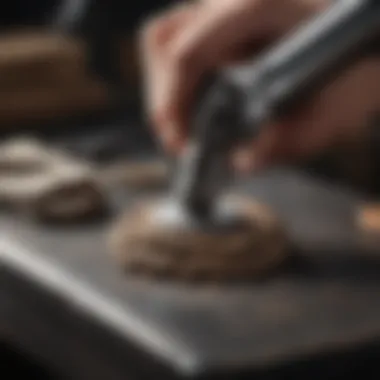Unveiling the Ultimate Dremel Type Tool Choices for Rock and Fossil Enthusiasts


Rock and Fossil Identification
In the fascinating world of rock and fossil identification, enthusiasts encounter a myriad of diverse specimens that hold clues to Earth's history. Various types of rocks and fossils present themselves, each with unique characteristics that aid in recognition. From sedimentary rocks like sandstone and limestone to fossils of ancient marine creatures or plant imprints, collectors must hone their eye for detail to distinguish these treasures. To assist in this endeavor, specialized tools such as magnifying lenses, chisels, and of course, dremel type tools play a crucial role in uncovering the hidden beauty of these geological wonders.
Before delving into the specifics of each tool, it is important to understand the key characteristics to look for when identifying rocks and fossils. Texture, color, hardness, and composition are paramount in distinguishing one specimen from another. Paying attention to details such as fossil markings, crystal formations, and sediment layers can provide valuable insights into the specimen's origin and age.
As collectors navigate through the vast realm of rock and fossil identification, having the right tools at their disposal is essential. While basic tools like hammers and chisels are vital in the field, dremel type tools offer precision and versatility in intricate detail work. These high-speed rotary tools allow enthusiasts to delicately sculpt, polish, and clean specimens with precision, enhancing the overall appreciation and understanding of each geological find.
Introduction
In the realm of rock and fossil collecting, having the right tools can make a substantial difference in how effectively and efficiently enthusiasts can pursue their geological passions. The focus of our discussion lies in unveiling the best Dremel-type tools tailored specifically for rock and fossil enthusiasts. These specialized tools offer a myriad of features and functionalities that cater to the intricate needs of collectors, shaping and refining their specimens with unparalleled precision.
A Dremel tool stands out as a versatile companion for rock and fossil enthusiasts, presenting a diverse range of applications beyond its conventional uses. From intricate detailing to efficient material removal, these tools serve as indispensable assets in the world of geological exploration and specimen preparation. By delving into the characteristics, functionalities, and benefits of Dremel-type tools, this article aims to provide enthusiasts with valuable insights to aid them in selecting the most suitable tool for their geological pursuits.
Exploring the realm of Dremel-type tools in the context of rock and fossil collecting, we will uncover the unique advantages these tools offer in terms of precision, efficiency, and versatility. By understanding the essential features and considerations associated with Dremel tools, enthusiasts can elevate their collection and preparation processes to new heights. Join us on this insightful journey as we navigate through the intricate world of Dremel tools, unraveling the layers of innovation and craftsmanship that make them indispensable tools for rock and fossil enthusiasts.
Understanding Dremel Type Tools
Diving into the world of understanding Dremel type tools is crucial for rock and fossil enthusiasts looking to elevate their hobby to the next level. Aspiring collectors can significantly benefit from grasping the intricacies of these versatile tools, which serve as indispensable companions in the exploration and extraction of rock and fossil specimens. By unraveling the core functions, advantages, and considerations associated with Dremel type tools, individuals can make well-informed choices that align perfectly with their geological pursuits.
Definition and Purpose
Overview of Dremel Type Tools
Embarking on an exploration of the overview of Dremel type tools unveils a fascinating array of features that sets these tools apart in the realm of rock and fossil collecting. The precision, power, and adaptability of Dremel tools make them indispensable for delicately handling intricate details while ensuring efficient material removal. Their compact yet robust design allows enthusiasts to navigate through intricate rock formations and delicate fossils with ease, making them a preferred choice for meticulous work.
Applications in Rock and Fossil Collecting
Delving into the applications of Dremel type tools within the context of rock and fossil collecting sheds light on their pivotal role in the field. From intricate detailing to precise shaping, these tools offer a wide range of functions that cater to the diverse needs of collectors. Whether sculpting fossils or polishing rocks, the versatile nature of Dremel tools allows enthusiasts to embark on a multitude of tasks with precision and ease, making them indispensable assets for any geological undertaking.
Key Features to Consider
Variable Speed Settings
The incorporation of variable speed settings within Dremel type tools revolutionizes control and precision during operations. Enthusiasts can effortlessly adjust the speed of the tool to match the requirements of different tasks, ensuring optimal performance across various materials. This flexibility not only enhances efficiency but also minimizes the risk of damage, offering a seamless experience for users seeking accuracy and finesse in their work.


Interchangeable Accessories
Unraveling the realm of interchangeable accessories underscores the adaptability and customization options provided by Dremel type tools. Enthusiasts can easily switch between a diverse range of attachments to cater to specific tasks, expanding the capabilities of the tool exponentially. From cutting to grinding to polishing, the versatility offered by these accessories empowers collectors to tackle a myriad of challenges with precision and efficacy, making each tool a multifunctional powerhouse in the collection process.
Ergonomic Design
Exploring the ergonomic design elements of Dremel type tools reveals a commitment to user comfort and efficiency. The ergonomic contours and lightweight construction of these tools ensure prolonged use without causing strain or discomfort. By prioritizing user experience, Dremel tools enable enthusiasts to work seamlessly for extended periods, enhancing productivity and precision in rock and fossil handling.
Benefits of Using Dremel Type Tools
Precision in Detailing
The precision capabilities of Dremel type tools redefine the art of detailing in the realm of rock and fossil collection. Enthusiasts can intricately carve out delicate features with unparalleled accuracy, ensuring that every stroke aligns with their creative vision. This level of precision not only enhances the aesthetic appeal of specimens but also allows collectors to showcase intricate details with unmatched clarity and finesse.
Efficient Material Removal
Efficient material removal stands as a hallmark feature of Dremel type tools, revolutionizing the excavation and shaping processes for rock and fossil enthusiasts. The powerful motors coupled with specialized attachments enable swift and seamless removal of unwanted material, facilitating the uncovering of hidden intricacies within specimens. This efficiency streamlines the collection process, providing a high level of control and finesse in material manipulation.
Versatility in Tasks
The inherent versatility of Dremel type tools elevates the capabilities of rock and fossil collectors, empowering them to explore a myriad of tasks with a single tool. From shaping and buffing rocks to delicately detailing fossils, these tools adapt seamlessly to diverse tasks, offering a holistic solution for enthusiasts with varied interests. The versatility of Dremel tools not only streamlines workflows but also enhances creativity and precision in geological pursuits, making them essential companions for enthusiasts seeking a comprehensive toolset.
Factors for Choosing the Right Tool
In the realm of rock and fossil collecting, selecting the right Dremel type tool is paramount to enhancing precision and efficiency in intricate detailing tasks. The factors for choosing the right tool encompass a comprehensive evaluation of various elements that directly impact the performance and user experience. By delving into the nuances of power, performance, and build quality, enthusiasts can make informed decisions tailored to their specific geological pursuits.
Power and Performance
Motor Strength
When exploring the aspect of motor strength in Dremel type tools, its significance cannot be overstated. A robust motor strength serves as the powerhouse behind the tool's performance, dictating speed, torque, and overall cutting/grinding capabilities. Opting for a Dremel tool with a high motor strength ensures seamless operation, especially when dealing with dense or abrasive materials commonly found in rock and fossil excavation.
One of the key characteristics of motor strength lies in its ability to deliver consistent power output, allowing for smooth and precise movements during intricate detailing tasks. This feature is particularly beneficial for rock and fossil enthusiasts seeking enhanced control and accuracy in their craftsmanship. The unique advantage of superior motor strength in this context is its capacity to tackle challenging materials with ease, resulting in efficient material removal and impeccable detailing results.
Battery vs. Corded Options
The choice between battery-powered and corded Dremel type tools is a pivotal decision that influences mobility, runtime, and overall versatility. Battery-powered options offer freedom of movement without being tethered to a power source, ideal for on-the-go tasks or fieldwork where access to electricity may be limited. Conversely, corded tools provide consistent power output without the need for recharging, ensuring uninterrupted operation for prolonged activities.


An essential characteristic of battery-powered models is their portability, enabling users to maneuver the tool effortlessly in various settings without restriction. This feature proves beneficial for rock and fossil collectors who engage in outdoor expeditions or remote locations where power outlets are scarce. On the other hand, corded options excel in consistent performance, making them a popular choice for individuals prioritizing continuous use over extended periods without interruptions.
Tool Accessories and Compatibility
Accessory Variety
The diversity of accessories available for Dremel type tools plays a crucial role in expanding their functionality and adaptability to a wide range of tasks. An extensive accessory variety offers users the flexibility to customize their tool for specific applications, including cutting, grinding, polishing, and engraving. When selecting a Dremel tool, the availability of diverse accessories enhances its utility and ensures optimal performance across various rock and fossil detailing requirements.
A key characteristic of accessory variety is the convenience it provides in switching between different accessories to suit distinct tasks seamlessly. This aspect proves highly beneficial for rock and fossil enthusiasts who engage in multi-faceted projects requiring varied tool attachments. The unique feature of accessory variety lies in its ability to unlock creative possibilities, allowing users to explore different techniques and achieve intricate detailing effects effortlessly.
Compatibility with Add-ons
The compatibility of Dremel type tools with additional accessories and attachments is a crucial consideration for enthusiasts seeking to expand the capabilities of their tools. Compatibility with add-ons such as extension shafts, routing tables, and specialty bits elevates the tool's versatility, enabling users to undertake specialized tasks with precision and ease. When evaluating Dremel tools, compatibility with a wide range of add-ons ensures future-proofing and the potential for skill development in rock and fossil craftsmanship.
One of the key characteristics of compatibility with add-ons is its seamless integration with the existing tool, allowing for effortless attachment and detachment of supplementary accessories. This feature offers rock and fossil collectors the flexibility to explore new applications and techniques without investing in multiple tools. The advantage of compatibility with add-ons lies in its ability to enhance the tool's functionality and adaptability, providing users with a comprehensive toolkit for diverse geological projects.
Top Picks in the Market
When delving into the world of Dremel type tools for rock and fossil enthusiasts, the section on top picks in the market holds particular significance. This segment serves as a pivotal guide for enthusiasts seeking the best tool to enhance their geological pursuits. Highlighted within this section are key elements, benefits, and considerations crucial for making an informed decision when selecting a Dremel type tool.
Brand Comparison
Dremel
Dremel, known for its precision and quality, stands out in the market due to its reputable performance and reliability. The key characteristic of Dremel lies in its robust motor strength, offering power and efficiency in rock and fossil-related tasks. This feature makes Dremel a popular choice among enthusiasts, ensuring smooth operation and consistent results. Additionally, the unique feature of Dremel includes a wide range of interchangeable accessories, increasing its versatility and adaptability for various detailing tasks within this article.
Black+Decker
In the realm of Dremel type tools, Black+Decker distinguishes itself through its user-friendly design and durability. The key characteristic of Black+Decker is its ergonomic build, providing comfort and easy handling during prolonged use. This aspect contributes to its popularity among rock and fossil collectors, ensuring a seamless experience while working on intricate projects. However, an advantage of Black+Decker is its diverse range of compatible add-ons, expanding its functionality and customization options for enthusiasts within this article.
WEN
WEN emerges as a competitive choice in the market, known for its affordability and efficiency. The key characteristic of WEN is its longevity and solid construction, offering lasting performance for extended use in geological tasks. This feature makes WEN a beneficial option for enthusiasts seeking a reliable tool at a budget-friendly price point. Additionally, the unique feature of WEN includes a variety of accessories that complement its model, providing versatility and convenience for rock and fossil collectors in this article.
Model Recommendations


Dremel
Dremel 4300 showcases excellence in functionality and precision, making it an ideal choice for enthusiasts focused on intricate detailing tasks. The key characteristic of Dremel 4300 lies in its variable speed settings, allowing users to tailor the tool's performance according to specific project requirements. This versatility makes Dremel 4300 a popular option for rock and fossil enthusiasts seeking meticulous results. However, a potential disadvantage of Dremel 4300 could be its higher price point compared to other models within the market.
Black+Decker RTX-B
Black+Decker RTX-B earns recognition for its robust performance and reliability, catering to enthusiasts requiring power and consistency in their projects. The key characteristic of Black+Decker RTX-B is its efficient material removal rate, enabling swift and accurate results in rock and fossil-related tasks. This efficiency makes Black+Decker RTX-B a favored choice among collectors aiming for productivity and precision. Nonetheless, a drawback of Black+Decker RTX-B could be its heavier build, potentially causing fatigue during extended use for specific users within this article.
WEN
WEN 2305 emerges as a versatile and cost-effective option for rock and fossil enthusiasts, offering reliability and functionality at a competitive price. The key characteristic of WEN 2305 is its compatibility with a wide range of accessories, providing flexibility and customization for various geological tasks. This adaptability makes WEN 2305 a practical choice for collectors seeking a tool that can evolve with their projects' demands. Still, one potential downside of WEN 2305 could be its limited motor strength for more demanding tasks compared to other models discussed within this article.
Maintenance Tips for Dremel Tools
In the realm of rock and fossil collecting, the upkeep of Dremel tools plays a critical role in ensuring optimal performance and longevity. Maintenance Tips for Dremel Tools is a pivotal section in this article, shedding light on the essential care practices necessary for these precision instruments. Rock and fossil enthusiasts rely on these tools to intricately carve, shape, and refine their specimens, making maintenance a non-negotiable aspect of tool ownership.
Cleaning and Storage Practices
Proper Tool Cleaning Techniques
Proper Tool Cleaning Techniques are the cornerstone of maintaining Dremel tools in peak condition. By delving into the specifics of Proper Tool Cleaning Techniques, rock and fossil enthusiasts can enhance the lifespan and functionality of their tools. The key characteristic of Proper Tool Cleaning Techniques lies in its meticulous approach to removing debris, dust, and residue that can hinder the tool's efficiency. This technique is a popular choice for enthusiasts as it ensures precision and accuracy in their work, ultimately aiding in the preservation of their valuable rock and fossil specimens.
Safe Storage to Prevent Damage
Safe Storage to Prevent Damage is a crucial aspect of Dremel tool maintenance to safeguard these precision instruments when not in use. Highlighting the importance of proper storage practices, this section elaborates on the key characteristic of Safe Storage to Prevent Damage, which is to protect the tools from environmental factors that could compromise their quality. By emphasizing the significance of safe storage, enthusiasts can minimize wear and tear, prolonging the longevity of their Dremel tools and ensuring consistent performance.
Regular Maintenance Guidelines
Lubrication of Moving Parts
Lubrication of Moving Parts is a fundamental element of Dremel tool upkeep, contributing significantly to their smooth operation and functionality. This section discusses the key characteristic of Lubrication of Moving Parts, which is to reduce friction and enhance the movement of components within the tool. By elaborating on the benefits of lubrication, including improved precision and efficiency, enthusiasts can appreciate the value it brings to their geological pursuits.
Inspection for Wear and Tear
Inspection for Wear and Tear forms a vital part of regular maintenance for Dremel tools, enabling enthusiasts to identify and address potential issues promptly. Highlighting the key characteristic of this practice, which involves thorough examination for any signs of deterioration or damage, this section emphasizes its role in preventing unexpected tool failures. By advocating for proactive inspection, enthusiasts can mitigate risks, ensuring uninterrupted use of their Dremel tools for rock and fossil exploration.
Conclusion
When it comes to exploring the world of rock and fossil collection, the importance of selecting the right tools cannot be understated. Throughout this article, we have uncovered the wealth of options available within the realm of Dremel type tools, shedding light on their varied features and functionalities. From understanding the precise detailing capabilities to the efficient material removal and exceptional versatility that these tools offer, it is evident that they play a crucial role in the pursuits of geological enthusiasts.
Moreover, the maintenance tips provided emphasize the longevity and optimal functioning of Dremel tools, ensuring they remain reliable companions in the pursuit of geological passions. By following proper cleaning, storage, and regular maintenance guidelines, enthusiasts can extend the lifespan of their tools and maintain peak performance throughout their rock and fossil exploration journeys.
In essence, the best Dremel type tool is not just a tool but a companion, a facilitator of artistic expression, and a conduit for creativity in the world of rock and fossil collecting. It empowers enthusiasts to delve deeper into their passion, unleashing their potential to uncover the beauty and intricacies of geological wonders. With the right tool in hand, collectors can sculpt, polish, and preserve their finds with precision and care, adding a new dimension to their experience and exploration.







